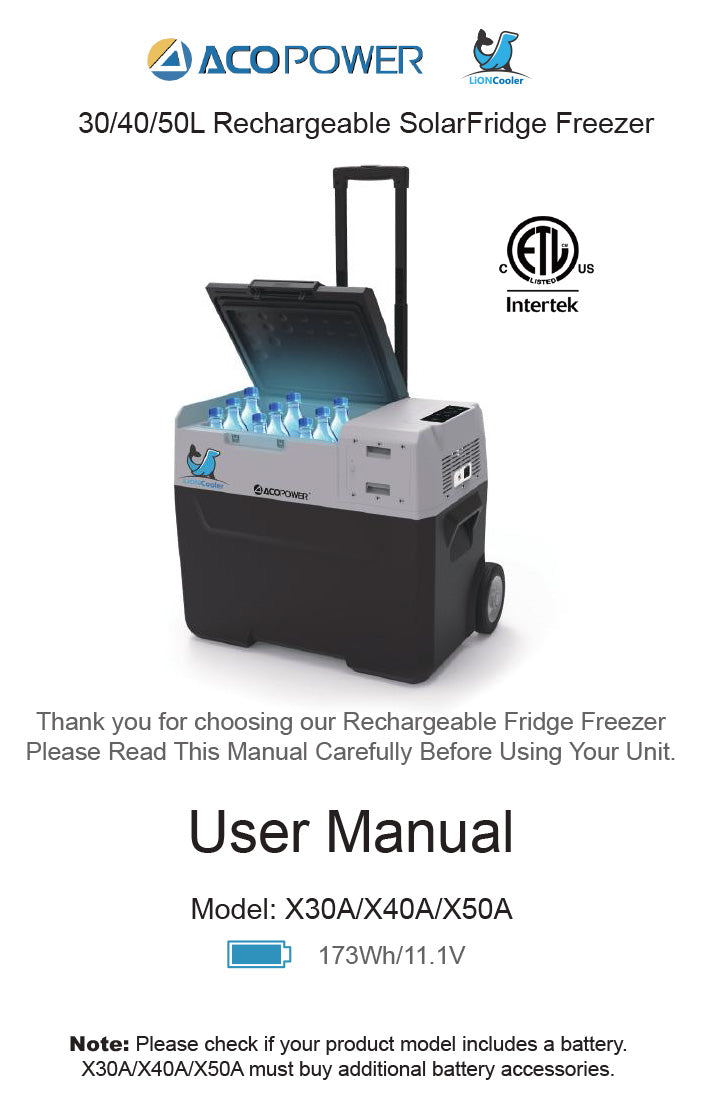
1. Features
- High efficiency DC compressor and conversion module with high reliability and long life; compressor delay protection
- Quick cooling to -15°C (based on 25°C ambient temperature), lowest to -20°C
- Built-in 15600mA/11.1V Lithium Ion battery 18650, 173Wh total.
- Battery recharging with solar panel (12v-50v), 12VDC and 100~240VAC power adapter, allows charging with solar panel, car cigarette or wall outlet
- Intelligent car battery protection system
- Portable design with trolley and wheels, removeable lid
- USB output +5VDC /2.1A for charging cell phone or iPad
- Fluoride-free insulation with good heat preservation performance and low energy consumption, 45w DC/AC power only
- Wide range electronic temperature control, LCD display
2. Safety Instructions
- Make sure the voltage is within the correct range for the socket and cable being used. See technical data label on the side of the unit for voltage ranges.
- The unit must be placed in a dry and well-ventilated place far from heat sources (such as stove, fuel), Place the unit in a well shaded area. Prevent exposure to blazing summer sunlight as this will cause overheating in the electronic compartment and product will be subject to failure. If compartment reaches an unsafe temperature, the LCD display will read error ‘F8’ and further instructions listed in section 7.FAQ of the user manual should be followed. Protection of the compressor is important to keep the product working at ideal conditions.
- Warning: Do not attempt or continue to operate your unit if electrical compartment is wet. The installation of the DC power source in a boat should be handled by qualified personnel.
- Your unit requires good ventilation; allow the following free space for air circulation: back 200mm and side 100mm.
- It is recommended to operate the unit on a flat surface. Maximum operation angle is 35°. During transportation, tilt less than 45° and handle carefully.
- No electrical devices should be placed inside the refrigerator, as they may be damaged.
- The inner tank allows water filling, but do not pour water out by inverting the unit. Keep the shells of the unit dry after rains. Do not submerge unit under water.
- Although the units have been cleaned before leaving the factory, we strongly recommend using a soft cloth dampened with warm water and a little neutral detergent to clean it again, then wipe with a dry soft cloth. (Warning: Electrical parts should be wiped by dry cloth only).
- Warning: Do not allow children to play games with the refrigerator such as climbing or standing in the refrigerator. They could damage the refrigerator and seriously injure themselves.
- Dustproof level and waterproof level: IP 24Do not use in extreme weather and harsh environments, such as sandstorms, storms, etc. This can cause serious damage to the product.
Load-bearing: less than 100Kg / 200Ib
Recommended ambient temperature: Less than 50℃ / 122 ℉.
Recommended humidity: Less than 90% R.H.
- Caution: As Power On status, do not tilt the product more than 45° or turn it upside down. It may cause a malfunction.
3. The Function and Operation Setting

- Power On/Off: Press the Power Button
 to turn the unit on/off
to turn the unit on/off - Temperature Setting: Can be adjusted by the “+” button up to 20℃ (Max) and down to -20℃ (Max) by the “- “button; Default temperature is Celsius degree (℃). If you would like to change to degrees Fahrenheit (℉), turn off the fridge, then press and hold the SET button over 3 seconds. E1 should be displayed on screen and begin flashing; continue to press the SET button until E5 shows up, then press + or -, select desired units: ℉ or ℃. The compressor will cool down the temperature from 10℃ to -10 ℃ in 20 mins.However, this reflects the change in temperature within the insulated walls of the fridge/freezer. Allow an additional hour or more time, depending on the food load, to reach a refrigerating temperature around 1-6 degrees Celsius. To reach freezing temperatures with food or beverage inside the unit will take approximately 8 hours. Therefore, if you want frozen or chilling temperatures inside, we suggest you turn on the compressor 10 hours ahead of time while keeping the temperature setting at -15℃ or lower.
- Cooling Mode Control: Press the “
 ” button to select control mode. ShortPresses will switch between MAX (Quick Cooling Mode) and ECO (Energy-saving Mode)
” button to select control mode. ShortPresses will switch between MAX (Quick Cooling Mode) and ECO (Energy-saving Mode) - (tip: Max mode is recommended to begin initial cool down). After desired temperature has been attained, it is recommended to switch to ECO mode to conserve energy cooling mode .
- Battery Protection: Selecting the H, M, L positions, you can choose different levels for car battery protection. When the unit is on and working, press the “
 ” button over 3 seconds, then the LCD will display as below:
” button over 3 seconds, then the LCD will display as below:
o L: Low power protection 9.0V (factory default)
o M: Middle power 10.1V
o H: High power protection 11.6 V
When the unit is connected to the car, we suggest setting the car battery protection to H level. L is suggested when the unit is powered with freezer battery or auxiliary backup battery.
- USB Output: +5VDC /2.1A for cell phone, tablet, WIFI speaker, etc.
Note: Don’t change settings on E1-E4, which is only for factory maintenance.
4. Power Supply and Charging
- Power Supply: The refrigerator is powered with 12VDC power
- 100~240V AC (adapter included) or backup Lithium battery if there is no connection of DC/AC power. The connected DC/AC power will operate the refrigerator directly and charge battery simultaneously.
- Battery Charging: The refrigerator allows three kinds of charging methods. 12VDC power, 100~240V AC with Adapter or solar panel (12V-50V) .
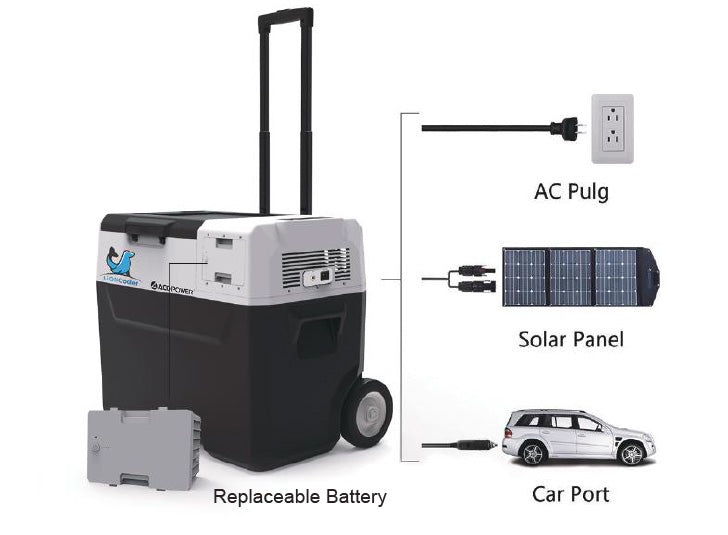
o DC/AC power connection: Car port and wall outlet cable included.

- Battery bank:
Model No:X200-A
Lithium Ion Rechargeable Battery:18650/15600mAh/173.16Wh
Nominal Voltage:11.1V
Limited Charging Voltage:12.6V
Limited Charging Current:3A
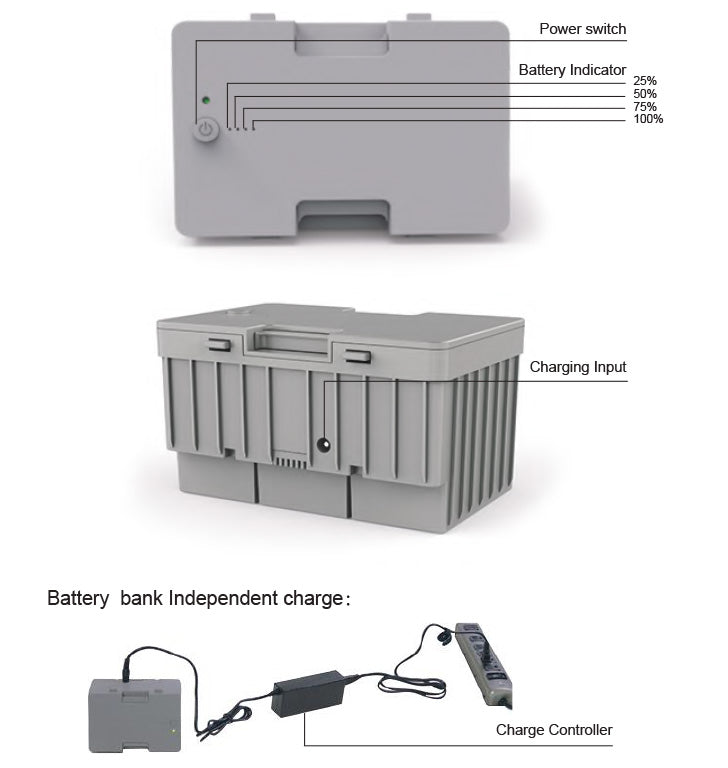
 When charging the battery bank separately, please use a special charger controller , or please contact us for details. For non-professionals, please do not open the battery.
When charging the battery bank separately, please use a special charger controller , or please contact us for details. For non-professionals, please do not open the battery.
- Solar panel (PV) charge connection:
NOTE: Battery bank switch must be used when charging with solar panel.Hold battery bank switch “ ” for 3Sec, LED indicator turn on Solar panel (PV) charge connection: Solar charge cable included (20ft Long).
” for 3Sec, LED indicator turn on Solar panel (PV) charge connection: Solar charge cable included (20ft Long).
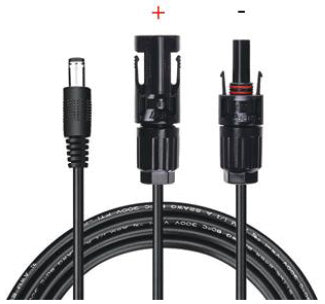
Insert the solar charge cable into the refrigerator’s “PV” terminal 
Max Solar input Voltage: 50V
Max Solar input Current: 10A
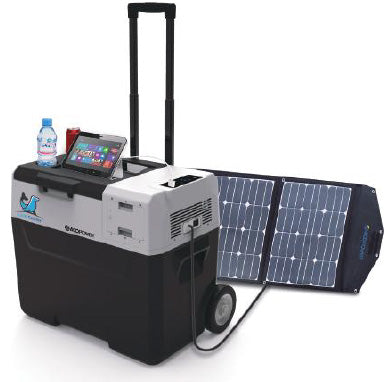

- Checking Charge Status: When the refrigerator is powered ON and DC/AC power is connected, the battery icon on display screen will flash to show charging. To charge the fridge/freezer battery without running the compressor,simply connect the adapters without powering ‘ON’ the unit. To view charging status please press and hold SET button “
 ” for 3 seconds. The unit’s battery status and voltage will be displayed. When the voltage reaches 12.6V and the battery icon stops flashing, the unit has been fully charged and wiring should be disconnected to prevent internal component damage.
” for 3 seconds. The unit’s battery status and voltage will be displayed. When the voltage reaches 12.6V and the battery icon stops flashing, the unit has been fully charged and wiring should be disconnected to prevent internal component damage. - Warning!!: Do not charge fridge/freezer with DC12V and Solar Panel at the same time! The unit may be seriously damaged and pose a potential hazard to you.
- AC Charging Management
- AC charging is always the first choice if AC power supply is available. Check AC voltage range and use AC adapter to connect with AC power outlet.
- We suggest charging the refrigerator battery to full using AC adapter before you leave for a trip or outdoor activity.
- If the fridge has not been in use for a long time the battery may have over discharged and unit will not power on. Please use AC adapter to charge unit to working mode. After unit has received up to 30% charge other charging methods may be used.
- Car Port Charging Management
- Engine Turned-on: You can choose any of H, M or L mode (see Battery Production in Chapter 5) and use car port power to operate the freezer.Different cars may have different power output voltages. If the voltage protection causes F1 error showed in the LCD, just set the battery protection from H to M or L. If the F1 error is still present, please charge the unit with the adapter for few minutes and normal operation will resume.
- Engine Turned-off: Charging using car battery: Most cars will stop power supply if engine is stopped, but some cars will continue power supply even when engine is stopped. You should adjust the battery protection to H,otherwise, the power of your car battery may run out and it may not have enough power to start car. You can also unplug the car port charger and run the fridge/freezer using its internal battery. If you don’t want to use car battery it is recommended to disconnect the car charger from the fridge and set Battery Protection to L mode. This will allow the refrigerator battery to work for a longer time in a safe and independent condition.
- Solar Charging Management
- When charging by solar panel, turn on unit to verify charging is in effect. Once confirmed, unit may be turned off. Press and hold SET “
 ”button over 3 seconds to show the battery status and voltage.
”button over 3 seconds to show the battery status and voltage. - When using solar panel to charge the freezer use the extension cable and keep the fridge in shade to avoid overheat and failure of refrigerator.
- When the refrigerator is powered ON and solar panel is connected to charge,the battery icon on display screen will flash to show charging status. Charging input wattage should be higher than refrigerator working wattage (about 40-45w), otherwise the battery will keep static. To ensure that solar charging power is higher than refrigerator operating power, a 100-Watt solar panel is advised.
5.Battery Power Operation
- Backup Power: The lithium battery is back up power as UPS power which keeps refrigerator operating while staying off grid.
- When charging the battery or using battery power, please follow the instructions to turn on the battery bank switch.( hold for 3 Sec)
- When not using the battery power or Freezer for a long time, please turn off the battery output. (Hold for 3 Sec)/Reduce battery power drain)
- Discharge Time:

- Maintain Battery Charged:
- Home/Hotel: Use AC adapter to charge unit from AC outlet.
- Car/Boat: Use DC port to operate the unit and charge the battery.
- Outdoor: Bring solar panel to charge the battery. Portable power station/ solar generator with AC outlet will be good companion of power supply.
- Saving Battery Power:
- Cool down before leaving: It is always suggested to charge freezer and turn on the unit to cool down in advance with wall/car outlet before the trip. To prepare for off-grid freezer, place food and beverage inside unit and let cool to appropriate temperature. This will allow off-grid battery to last longer while saving energy during outdoor activities.
- Operated at ECO and L mode: set the unit at ECO and L mode.
- Battery Disconnection: Battery can be removed or disconnected with side button (for some production). This will prevent the self discharge. The product will work with AC adapter or car outlet without battery connection.
- Note: Please charge fully before storage longer than 1 month.
6. Connect to Bluetooth
As for Bluetooth function, you need to download our Bluetooth APP as below:
1. Android System: just go to Google Play Store and search "SolarFreezer" then you will find the APP whose icon as 1st attachment shows;
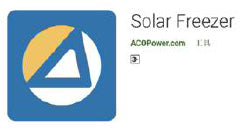
2. IOS system: just go to App Store and search "Portable Freezer" then you will find the APP whose icon as 2nd attachment shows.

User's manual
1. Turn on Freezer power
2. Turn on Bluetooth app
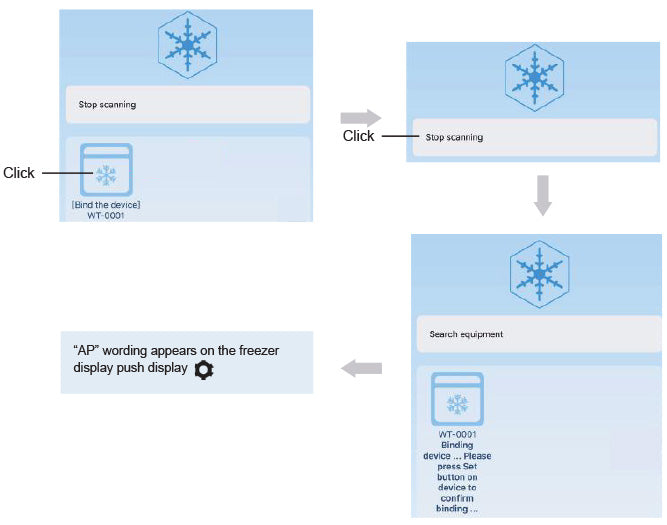
3. Main interface operation settings
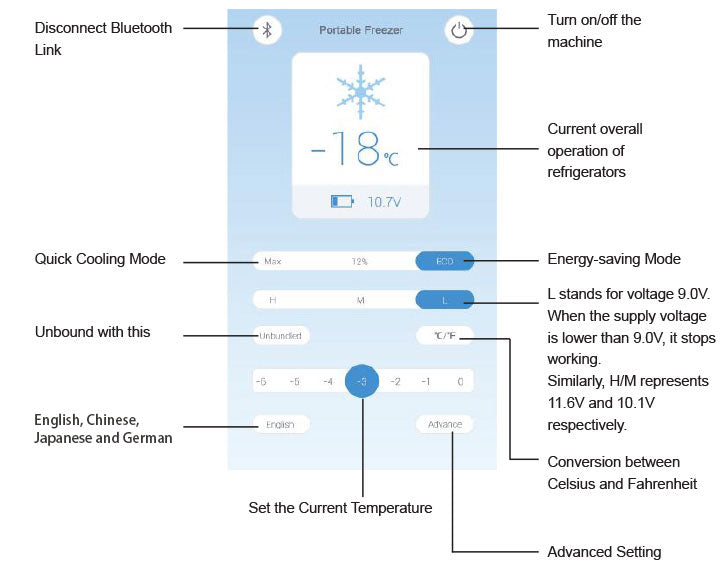
4. Advanced Setting
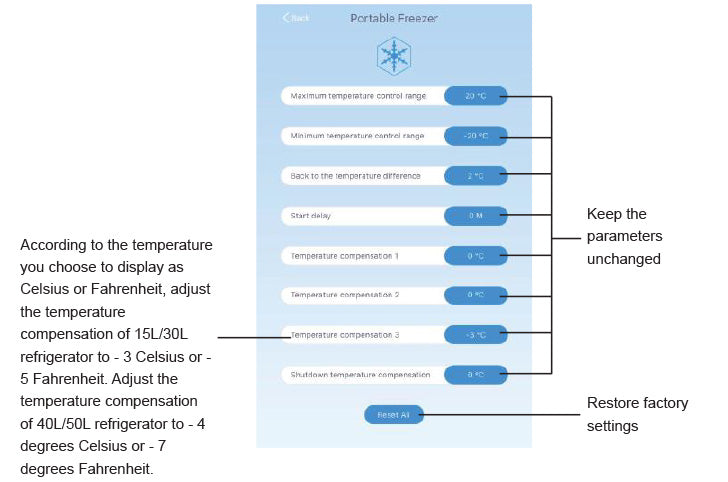
Note:
1. LionCool Bluetooth version 4.2, please confirm that the phone Bluetooth version is over than 4.2, Bluetooth 4.0/4.1/4.2
2. If the connection fails, please turn off the battery switch ( or unplug the battery) turn on the battery switch again ( or insert the battery,) Open the APP and connect again.
7. FAQ
- The appliance is not working:
o Check that the battery bank switch is turn on
o Check the power supply connection
o Check the plug and the socket connection.
o Check for burnt fuse.
o Ensure unit has been properly powered to ‘ON’ mode.
o Compressor may be in delay start protection.
- The food inside is frozen: The setting temperature is too low
- Hear water from the inside of fridge: It is normal, due to the flow of refrigerant.
- Display F1 code: Low power protection: setting the protection from H to M or L
- Display F2 code: Fan overload protection: turn off unit and restart the unit after 30 minutes
- Display F3 code: The compressor protection is activated: please turn off the unit and restart the unit after 30 minutes.
- Display F5 code: Compressor controller module protection is activated: please turn off the unit, keep it in a well-ventilated location and restart the unit after 30 minutes.
- Display F7/F8 code: Temperature sensor error: please move the unit in regular temperature area for a while, then restart the unit.If you still have the error, please contact us for support.
- High temperature - it causes the cooling effect to be inconspicuous:If the compressor temperature of the refrigerator exceeds 75 ° C / 167 ° F, it will turn on over temperature protection and stop working.
- The cooling temperature cannot be lower than the ambient temperature of 50 ° C /122 ° F. Example: Ambient temperature 50 ° C / 122 ° F. Then the maximum effect inside the refrigerator will reach 0 °C / 32 °F.
8. Food Storage
- Freezer (-20 °C~0°C):
o Meat should be cut and wrapped tightly, and then averagely placed inside. After buying frozen food, put it in the freezer at frozen condition.
o Do not put the fresh food and frozen food together.
o Do not put the fruit and vegetable in the freezer to avoid freeze-drying.
o Do not put the glass container or other container with sealed liquid in freezer. Or there is a possibility of explosion.
- Refrigerator (0°C ~10°C):
o Eggs, butter, milk and bottled drink can be put in refrigerator.
o Fruit and vegetable should be put in bags for moisture retaining.
o Hot food should be cooled down before it’s placed to save power.
o Food must be packed into bags. Leaving space between packaged foods to keep the circulation of cool air.
9. Defrosting
- After the refrigerator has been on for a period, frost could be seen on surfaces in the freezer, which reduces refrigerating effect and increases power consumption.In this case, you need to defrost it.
- Unplug the refrigerator and open the doors, take the food in the refrigerator to a cool place. Use defrosting shovel to remove ice and frost (also can just let the door open, then ice and frost will be thawed by the raising temperature). Then use dishtowel to wipe off the ice water. After that, place the food back to the refrigerator and plug in.
- Note: Do not use sharp metal tools to defrost which will damage the refrigerator
10. Care and Cleaning
Unplug the refrigerator before cleaning!
- Use soft cloth dampened with warm water to wipe the inner surfaces and external appearance of the refrigerator.
- Use neutral detergent to clean the heavy stains, and dry with clean soft cloth.
- For long vacation or absences, remove food and unplug the refrigerator. Clean the refrigerator and leave the doors open a little. Then place the refrigerator in ventilated place.
- Do not use cleansers containing corrosive and deliquescent material (such as scouring powder, bleach, soap powder, alkaline cleansers, benzene, gasoline, acid,water, etc.) to clean the appearance panels, door gaskets and parts.
- NOTE: Do not sprinkle water on the refrigerator during cleaning because that would reduce the insulating property of electrical components and erode the metal parts.
11. The Following Situations are Normal
- The flow of refrigerant through the evaporator may create a boiling or gurgling sound.
- In the rain and high humidity weather, moisture may form on the outside of refrigerator or door gaskets. You can wipe damp surfaces with dry cloth.
- The temperature on the back panel may be high (particularly in summer) due to the heat emission of the condenser.
- The temperature on external surfaces of the compressor may be high when the compressor is working.
- The compressor may cause a high hum or pulsating sound when it is at starting or stopping.
- It's normal to hear metal clanking noises from the compressor when the refrigerator is bumped.
- There may be a slight smell coming from the rubber wheels. This is harmless for health.
12. Technical Specification
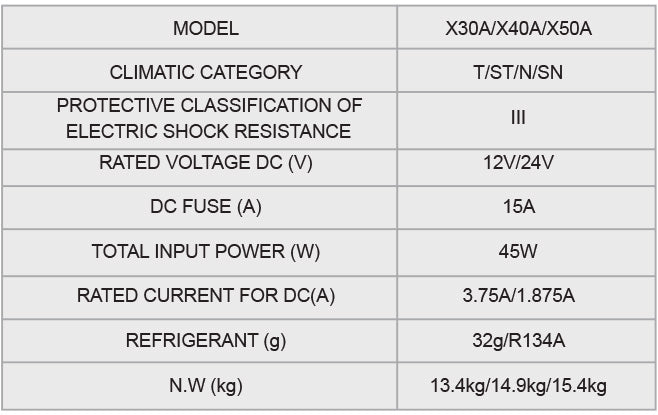
13. Guidelines for Protection of the Environment
 DISPOSAL: Do not dispose this product as unsorted municipal waste.Separate collection of such waste is necessary for special treatment and disposal.
DISPOSAL: Do not dispose this product as unsorted municipal waste.Separate collection of such waste is necessary for special treatment and disposal.
Meaning of crossed-out wheeled dustbin: Do not dispose of electrical appliances as unsorted municipal waste. Use separate collection facilities. Contact your local government for information regarding the collection systems available. If electrical appliances are disposed of in landfills or dumps, hazardous substances can leak into the groundwater and get into the food chain,damaging your health and well-being.
Danger!
- Do not put the portable power pack into water or get it wet.
- Do not charge or store near fire or under extreme heat, especially when leakage happens.
- Do not mix up positive electrode and negative electrode.
- Do not connect directly to AC power source.
- Do not transport or store with necklace or other metal material, this may cause short circuit.
- Do not puncture or open, stamp, or impale.
- The terminals cannot be welded directly.
- Cannot be decomposed.
- Do not place in microwave ovens or pressured vessels.
- Do not combine with a one-shot battery or battery with different capacity, model or type.
- Do not use if abnormalities are noticed such as smoke, excessive heat, etc.
14. Pack List

15. Warranty
One-year warranty for unit.
Please visit our website and make warranty registration:
https://www.acopower.com/apps/product-registration
